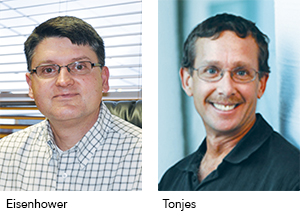By RENEE STOVSKY

Social worker Caitlin Andrews, right, meets with Rebeca Minoza on the day her husband Antonio Minoza is discharged from PeaceHealth Ketchikan Medical Center following treatment for diabetes and a foot infection. Uninsured, he qualified for charity care and the hospital helped him enroll in a program that provides his insulin at no cost, Andrews said.
Caitlin Andrews, a social worker and part of PeaceHealth Ketchikan Medical Center's innovation program team, remembers well one of the first patients she encountered as a care coordinator attr the hospital — a homeless man who had visited the emergency room more than 50 times in a single year.
"He was only 50, but he had congestive heart failure as well as other chronic health problems. In addition, he came down with pneumonia," she says. "As an inpatient, he would be treated and his condition would improve, but as soon as he was released, he would return to the street, get sick again and wind up back in the ER."
As caseworkers will attest, finding the homeless primary care anywhere is tough. In Ketchikan — a town of 12,000 in rural southeast Alaska — the challenges are even more daunting.
"There is a huge population with no medical coverage whatsoever here," says Andrews. "There is also a critical shortage of mental health services and very few small group homes that take clients on general relief," or welfare.
It took Andrews a year to get proper services lined up, but today the man lives in a group home located several hours from Ketchikan, and his health has stabilized.
 'Triple Aim'
'Triple Aim'
The emphasis on using frontline care coordinators like Andrews to address both psychosocial and clinical hurdles for patients is a central aspect of a patient care approach at PeaceHealth Ketchikan Medical Center that is funded by a Centers for Medicare and Medicaid Services Health Care Innovation Award. PeaceHealth Ketchikan is one of 107 sites in the nation — and the only one in Alaska — to be chosen for the innovation grant. It was awarded a three-year, $3.2 million grant to find innovative ways to "provide better care, leading to better health, resulting in lower costs."
That goal — called the "Triple Aim" by the Institute for Healthcare Improvement — is one that is consistent with the medical center's own mission of promoting individual and community health, relieving pain and suffering and treating each person in a loving and caring way, says Matthew Eisenhower, director of special programs at PeaceHealth Ketchikan.
Eisenhower, along with Ken Tonjes, chief administrative officer at PeaceHealth Ketchikan, will present an Innovation Forum session titled "Rural Care Coordination: Overcoming Psychosocial Hurdles" at the Catholic Health Assembly, June 7-9 in Washington, DC.
Above and beyond
Innovation team member and practical nurse Lisa McCranie spends most of her time equipping diabetic patients with information to better understand their disease, improve their lifestyle and nutrition choices and effectively manage their medications. But she also provides transitional care management for patients who need to travel outside the area for medical procedures not available in Ketchikan.
"We have arrangements with hospitals in locations like Seattle to take patients who need surgeries, cardiac care and other procedures that we can't provide. We even have funding in place to help with $60,000 medevac costs to transport patients," says McCranie. "But we also feel it is important to follow up with our patients, even while they are out of town, to ensure the best outcomes for them."
Recently, McCranie says, she had a patient who traveled to Bellingham, Wash., for surgery. While she was still in the lower 48, McCranie was in constant contact with her, discussing therapy, postsurgical appointments, medications and possible complications.
"The patient was recovering but was very nervous about reinjuring herself on the 38-hour ferry ride back to Ketchikan," says McCranie. "We supported her by constantly following up with her, empathizing with her concerns, reassuring her, letting her know that we care so that she could take better care of herself while she was away from her home community."
Says Eisenhower: "Catholic charity works with individuals beyond their physical needs. This program, too, goes beyond clinical concerns; it allows us to tap into a healing process beyond science — one that helps with other life hurdles."

Care coordination at PeaceHealth Ketchikan Medical Center in Ketchikan, Alaska, encompasses routine and nontraditional services such as assistance with expensive medevac bills for needy patients who require tertiary care elsewhere. Located on the southern tip of the Inland Passage, Ketchikan is 31 miles long and 10 blocks wide, according to the state's tourism website.
PeaceHealth Ketchikan received the CMS grant in the fall of 2012; the innovation program became operational in January 2013. To date, Eisenhower says, the results have been encouraging.
"Our 30-day readmission rates have decreased, our general costs per patient are decreasing and there have been dramatic improvements in the way our patients with chronic diseases have been managing their own care," he says.
"This is a wonderful program, and we are pleased with the outcomes so far," agrees Tonjes. "There is elegance in its simplicity. We've made health care in America so complex that you almost have to be a professional to navigate it. This allows care coordinators to spend time and resources upstream to reduce or eliminate costs downstream."
Cost and benefit
However, hospital administrators had to "really huddle and ask if this was something we wanted to pursue when we embarked on writing the grant," says Tonjes. "Yes, it was consistent with our mission, but we were proposing a million-dollar-plus investment in staffing care coordinators with the idea of reducing revenue streams. It was a double whammy."
Tonjes says he believes the program ultimately will make financial sense — in addition to the benefit it provides to patients and the community — as health care reimbursement mechanisms change from a fee-for-service model to a population management model.
"The Affordable Care Act is challenging providers to look at new ways to provide health care by avoiding so much expensive care and focusing more on preventative care, as well as by helping people manage current conditions — both acute and chronic — by navigating the system," he says.
"In an ideal world, at the end of our three-year grant, a switch would be flipped to population-based reimbursement, and we would be prepared with a basic infrastructure," he says. "We already have the data proving it is the right thing to do, both from a health standpoint and the efficiency of providing health care services. But this is a new frontier, and particularly in rural Alaska, we are at risk of lagging behind."
Nevertheless, says Eisenhower, PeaceHealth Ketchikan is committed to continuing the innovation program. "This is working for our patients, so we are looking for philanthropic sources to fund the gap until reimbursement models mature."
| Triple Aim: Case, care and population health management |
PeaceHealth Ketchikan Medical Center's innovation team — composed of three registered nurse care coordinators, one licensed practical nurse, one master of social work, one financial coordinator and one registered nurse clinical educator — addresses three broad areas of concern in rural health care across America: - Case management allows nurses to help sick patients navigate their care properly.
- Care management allows nurses, dietitians and other care coordinators to help patients with chronic conditions like hypertension and diabetes avoid complications through patient education and long-term motivation.Population health management provides community outreach and educational programs, such as "Living Well Alaska," based on a Stanford University program, to help keep healthy people healthy.
- Population health management provides community outreach and educational programs, such as "Living Well Alaska," based on a Stanford University program, to help keep healthy people healthy.
Patients enter the program in one of three ways: - A provider, such as a family doctor, may identify a patient hurdle to treatment — be it financial, psychosocial or even a transportation issue — to a program care coordinator.
- A care coordinator may reach out to a patient with a chronic condition after that patient is identified by a hospital registry or an electronic software program like EPIC as having a potential problem. (In the case of a diabetic, for instance, a recorded rising A1C level could trigger a call.)
- A nurse care coordinator makes follow-up contact within 48 hours of discharge to all hospital inpatients and emergency room patients to discuss next steps of care. This is an in-depth phone call that focuses not only on medication dosages but also on problems such as meal preparation; wound care; and whether assistance is needed to enroll in prescription assistance programs, provide taxi vouchers or bus tokens, and so on.
|